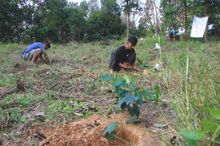 29 Oct 2023
29 Oct 2023
Restoration of nature in the Himalayas has been crucial like never before because the impact of climate change, especially the rise in Earth's temperature, is melting the ice caps and turning those shiny white mountains into black rocks. The weather reports and the recent research data suggest that the growing effects of climate change will convert those mountains covered in snow to black stones before the end of 2050 AD. It sounds like a disaster. Can we even imagine what will be its practical impact? The sea level will rise yearly by double the ratio it is increasing now, so the average temperature on the Earth will reach more than 50 degrees Celsius. This phenomenon does not sound like a livable environment for humans and other animals. How can we prevent this disaster from happening? The only realistic answer is conserving the natural existence of the ecosystem right now. Though there are many propaganda, organizations, and missions every year to combat the impact of climate change, none of them can give real solutions to the existing problem. A practical action to fight against climate change and its impact, forest conservation is the best solution as it supplies a lifeline to many ecologically delicate systems and units. Himalayan Adventure Therapy is on a mission to restore the depleted forest from Nepal and set an example of conservation globally.
The reforestation campaign has directly helped increase the area covered by forest and the density of forest in pre-existing forest sites. The target area for reforestation is around the depleted forest region. Accordingly, the new saplings are planted based on the climatic condition of the site and the nature of the pre-existing forest in the area. The local community near the reforestation sites is encouraged to participate in the restoration campaign directly. We have offered them incentives and the assurance of their future life by forming a conservation committee that will now benefit from the campaign-leading organization. As we have been experiencing human and wildlife conflict growing in recent years, the plants are mostly the fruits to feed those local wild animals like monkeys and others whose food depends on fruits and vegetation. Accordingly, the reforested species are also ornamental plants to help the regional conservation community earn from the same forest they are protecting. This way, we have encouraged the local community members to take care of forests for themselves rather than the general global cause, which they would have never cared for.
Two hundred new saplings of fruits, ornamental plants, and the local plant species are planted in a well-prepared pit with organic fertilizers and loose soils mixed. The fruit species will help reduce the region's human-wildlife conflict as local people complained about the monkeys taking away their crops from the field. Ornamental plants will add economic value for those directly involved in conservation campaigns. They are allowed to sell the bi-product of the forest in the market to make some money and use it to fulfill their personal and family requirements. The local species will help the current forest remain intact and expand in an area covered by it. The size of about 670 sq meters is now re-planted with new saplings, and furthermore, in the next six months, we plan to plant an equal or more area of the land with new saplings. This way, the organization will be rigorous in increasing the area covered by forest in a periodic manner. If we can get the aid, we will exponentially increase the forest-covered land area in the hilly region of Nepal that lies just below the Himalayas. The green line in the Hilly region will help cool down the Himalayas, eventually preventing it from the impact of global warming.
Wildlife and many other natural units rely on the forests to continue their natural ecology. The forest is considered as a lung of the Earth. When it gets depleted, every part/component of the body or Earth suffers. Suffering is primarily irreversible and can not be undone in terms of the damage leading toward the devastating path of extinction, whether it is human civilization, the old forest ecosystem, or the thriving wildlife on Earth. The corporate world, which regulates the economic world, must consider conserving the natural existence and act now rather than just making propaganda. The ultimate source for any conservation approach is initiation and effective action. The organizational strategies make considerable impacts in contrast to the individual courses. So, we have started the campaign; join us or begin yours where you are.







